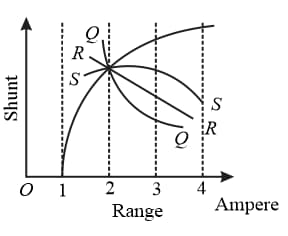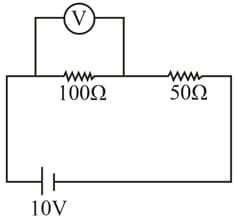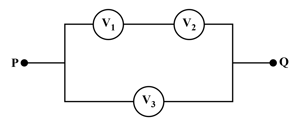Conversion of Galvanometer to Ammeter and Voltmeter
Conversion of Galvanometer to Ammeter and Voltmeter: Overview
This topic covers concepts such as Conversion of Galvanometer into an Ammeter, Conversion of an Ammeter to a Higher Range Ammeter, Conversion of Galvanometer into a Voltmeter, Conversion of a Voltmeter to a Higher Range Voltmeter, etc.
Important Questions on Conversion of Galvanometer to Ammeter and Voltmeter
A galvanometer has a resistance of . It gives full scale deflection with a current of 2 mA. Calculate the value of the resistance needed to convert it into an ammeter of range
Out of the two, an ammeter or a milliammeter, ammeter has a higher resistance.
How do you convert a galvanometer into an ammeter?
A moving coil galvanometer has the following characteristics- Number of turns of coil, Area of coil, Resistance of coil, the flux density of radial field, Torsional constant of suspension wire. Calculate the voltage sensitivity.
The voltage sensitivity is defined as the deflection per unit current.
What is the SI unit of the voltage sensitivity?
Write the expression of the voltage sensitivity.
A moving coil galvanometer produces deflection for current . Calculate current sensitivity?
The SI unit of current sensitivity in galvanometer is
A convenient way for the manufacturer to increase the current sensitivity is to increase the number of turns in the galvanometer.
Write the expression for the sensitivity of the ammeter.
A galvanometer has current sensitivity of divisions per with equal divisions. The shunt resistance in required to convert given galvanometer into an ammeter of range is . Write the value of to the nearest integer. Here, galvanometer voltage is .
The ammeter has range of , without shunt. The range can be varied by using different shunt resistances. The graph between shunt resistance and range will have the nature as

A moving coil galvanometer of resistance is used as an ammeter using a resistance . The maximum deflection current in the galvanometer is . Find the minimum current in the circuit so that the ammeter shows maximum deflection.
A moving coil galvanometer of resistance is used as an ammeter using a resistance . The maximum deflection current in the galvanometer is . Find the minimum current in the circuit so that the ammeter shows maximum deflection.
A voltmeter has a coil and in series. The coil takes for full-scale deflection. The maximum potential difference which can be measured is -
In the given circuit, voltmeter reads The resistance of the voltmeter is:

What resistance should be connected in series of a galvanometer of resistance in order to change its range from volts to volts (in )
Three voltmeters all having different resistances are joined as shown. When some potential difference is applied across and , their readings are and respectively. Then

The resistance of a voltmeter is . When there is potential difference across its ends, it gives full-scale deflection. What resistance (in ohm) should be connected in series to obtain a full-scale deflection at?
